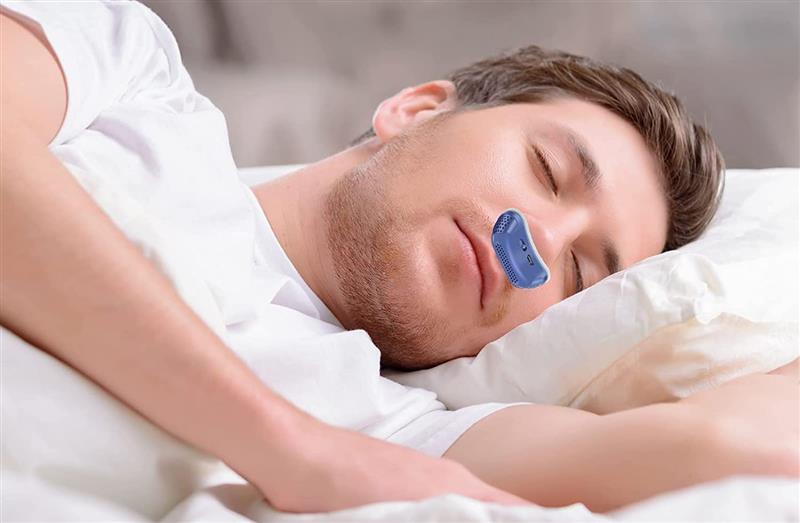
Snoring causes discomfort and a lack of sleep for both the snorer and anyone else in the room. Furthermore, it has been linked to a variety of metabolic disorders, including cardiovascular disease.
Nasal snoring
Snoring treatments can be surgical or non-surgical; which type is used depends on the cause of the snoring.
In snorers, nasal snoring is characterised by the creation of negative pressure and partial collapse of the pharyngeal airway. The obstruction of the upper airway is the cause of the snoring. Nasal devices can help keep the airway open and reduce snoring. One method of identifying patients who may benefit from these devices is the Afrin test.
Nasal anti-snoring devices, such as nasal strips or nasal dilators, can often help with nasal snoring. Both of these keep the nostrils open while sleeping.
Nasal strips are self-adhesive tape strips that are used to separate the nostrils.
Nasal dilators, which are made of plastic or metal, work by pushing the nostrils open while sleeping. Because their efficacy has not been directly compared, either of these may be used.
Syndrome of obstructive sleep apnea (OSAS)
OSAS can be treated using one of several methods:
- Oral CPAP (continuous positive airway pressure) devices
- Surgery
Oral appliances
If CPAP fails or is not acceptable to the patient, oral appliances may be used instead. They may also be indicated in patients with mild to moderate OSAS who do not experience daytime sleepiness.
Chin strips
Chin strips are self-adhesive tape strips that are fastened under the chin to keep the mouth closed while sleeping.
Vestibular protection
This plastic device is placed inside the mouth to block airflow and encourage nasal breathing, which often prevents snoring.
In terms of available research, both of these devices are comparable.
Devices for mandibular advancement (MAD)
These devices are used to prevent snoring caused by tongue base vibration. They move the lower jaw and tongue forward to make more room for airflow in the pharynx, preventing tongue vibration in this area.
A thermoplastic MAD can be purchased ready-made and fitted in the patient's home. Individuals with a strong gag reflex or those who cannot sleep with appliances in their mouth may not be able to use or tolerate these devices. Initially, it may cause pain in the face and jaw. For those with OSAS, a custom-made MAD made by a dentist is recommended; however, these are much more expensive.
Modern MAD are lighter, less bulky, and even micro-adjustable, allowing each individual to adjust the amount of jaw protrusion needed to stop snoring without putting undue strain on the jaw and facial muscles. These devices will need to be replaced every 18 months.
Tongue-retention devices (TRD)
The TRD is another oral appliance that prevents the tongue from falling back during sleep, which causes snoring in many people. It uses a slight negative suction to keep the tip of the tongue in place. The associated mouthpiece also causes mandibular protrusion, which is reduced to a comfortable level based on patient feedback.
This can also be increased if snoring persists despite the use of the device. If the nose is blocked, orifices on the TRD allow for mouth breathing. This may cause some discomfort at first, but it is completely safe and has been shown to be effective in many snorers. It also reduces sleep apnea and daytime somnolence.
The Benefits and Drawbacks of Oral Appliances
Oral appliances can cause discomfort, a feeling of a foreign body, excessive salivation, or mouth dryness. They are typically used following a sleep study to identify the risk factors for OSAS and, if present, to diagnose it, as well as to provide a baseline to assess progress with the use of the appliances. They are reversible, easy to use, inexpensive, and effective, and thus provide an alternative to CPAP in many patients.
Adjustable oral appliances necessitate orthodontic skills and are thus significantly more expensive than fixed appliances. They take longer to make and build tolerance to, but they are more effective in reducing snoring in all types of OSAS patients. Younger patients with a slimmer build and lower BMI who have mild to moderate OSAS have the highest success rates.
Fixed appliances are less expensive, easier for the patient to fit, and act faster. They can't be adjusted to provide more or less mandibular protrusion, so they don't work to stop snoring.
In general, oral appliances are more acceptable than CPAP in people with OSAS.
A more recent device relies on the ability to teach a conditioned reflex. When snoring begins, it begins to vibrate, causing the sleeper to turn to the side. It aids in the reduction of daytime sleepiness while having no effect on or improving sleep quality.